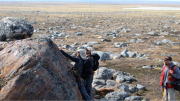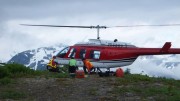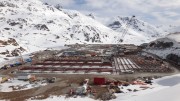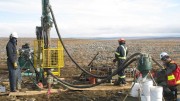VANCOUVER — Colorado Resources (TSXV: CXO) has a plethora of targets to choose from at its rugged 305 sq. km KSP property in northwest B.C, but this year the junior is after high-grade gold at the historic Inel showing, 15 km southeast along strike of Skeena Resources’ (TSXV: SKE; US-OTC: SKREF) past-producing Snip mine.
The company expects to begin a 5,000-metre drill program by mid-June, with holes targeting the shallow mineralization down to 150 metres deep.
Colorado president and CEO Adam Travis told The Northern Miner at the Kamloops Exploration Group conference in Kamloops, B.C., that the company switched focus from bulk-tonnage porphyry copper-gold targets to vein-hosted gold because “in markets like these, grade is king.

Looking northwest towards Khyber Pass with Inel over the back side of the hill. Photo by BC Geological Survey Branch.
“We made two new porphyry discoveries last year, but now everybody wants grade,” he said. “So we’ve been looking at Inel, but we weren’t going to drill it until we compiled all the historical data, otherwise we’d be flying blind.”
Travis explained that the hunt for data led his team into the basement of a former Cominco geologist, where they blew the dust off 190 hand-drawn drill sections, a number of underground geology maps and accompanying samples.
On the pages, Travis read that between 1980 and 1991, explorers braved the glacier cover and targeted two mineralization zones — the Discovery and AK zones — with 17,500 metres of drilling largely via 1,240 metres of underground exploration drives.

Colorado Resources’ KSP property in northwest British Columbia. Credit: Colorado Resources
According to B.C. Minefile reports, the work at the Discovery zone outlined a polymetallic, possibly volcanogenic massive sulphide deposit with one “lens” of mineralization returning a historic resource of 317,485 tonnes grading 3.4 grams gold per tonne, 0.1% copper, 0.1% lead, 2.6% zinc and 13.3 grams silver per tonne.
At the AK zone — 600 metres north — mineralization was outlined as being more intrusion-related, focused along the edges of a dyke swarm and hosted within breccias and vein stockworks.
The last stab at exploration occurred in 2001, when Gulf International Minerals paid a visit to see if the glaciers had retreated enough to warrant another look at the prospects.
It was noted in the company’s report that “there has never been a comprehensive surface-mapping and sampling program,” and the “underlying controls and orientation of mineralization are not well understood.”
Gulf International saw the retreating icefields and recommended more work, but the prospects fell into dormancy until Colorado optioned the land claims in 2013 from SnipGold (TSXV: SGG).

From left: Carl Hering (Director), Adam Travis (President, CEO and Director), Jim Oliver (Chief Geoscientist), and Bill Lindqvist (Director) at the Tami Zone of KSP in 2015. Credit: Colorado Resources
“What we’ve learned from the data is that many of the controls of gold mineralization are flat,” Travis said. “From underground, they were trying to drill a flat target from a flat drill hole, and that must’ve been a real struggle.”
Highlights from historical drilling include 7.4 metres of 20.93 grams gold and 5.4 metres of 38.08 grams gold at the AK zone, whereas the Discovery zone returned 4 metres of 30.28 grams gold and 3 metres of 15.76 grams gold. Other zones, such as Inel Creek, hit 3.5 metres of 423.81 grams gold.
But Travis said the bigger picture came together when he and his team compiled the surface data with new and old geochemistry from soil samples, which painted a glowing 1.5 sq. km gold-in-soil anomaly grading 1.27 grams gold over the area.
“I’ve never seen an anomaly quite like that in my entire career,” he said, noting that the “soils” on the property consist largely of scree. “The previous explorers never had the surface exposure or technology as we have now, so when we combine our new data we see that the anomaly is significantly larger than the areas they previously drilled.”
Travis points out that recent mapping suggests mineralization is focused along the edges of three north-trending mafic intrusives that could extend for at least 1 km, as interpreted from the soil anomaly.
He draws similarities with the historical Snip mine, which produced 1 million oz. gold at grades of 25 grams gold from an orebody trending 300 to 400 metres along strike, and plunging to 500 metres deep.

Massive sulphide boulder from 1988 underground workings at Inel with old equipment and drill rods in the back and foreground. Credit: Colorado Resources
“I really want to be a cheerleader for northwest B.C., because it’s a special part of the planet. Within 1,000 sq. km you have the world’s largest undeveloped gold resource at Pretium’s Valley of the Kings deposit, one of the world’s largest accumulations of copper and gold at Seabridge Gold’s KSM property, Eskay Creek was the world’s highest-grade precious metal volcanogenic massive sulphide, and here we are in the middle of it. It’s a good place to be.”
Seabridge Gold (TSX: SEA; NYSE: SA) has agreed to acquire SnipGold at a 124% premium because of possible synergies with personnel and infrastructure, and “geological similarities” shared between their properties.
Travis said that the proposed business arrangement won’t affect Colorado’s underlying agreement with SnipGold, reiterating that KSP represents the “attractive half” of SnipGold’s land tenure.
“There’s a much bigger story happening right now, and it’s been 50 years in the making. Infrastructure has changed, Imperial Metal’s Red Chris has come online, Pretium will open a mine next year and all the reputable names like Ron Netolitzky, Robert McLeod and Larry Nagy have all come back to where they began their careers. The glass has transferred from half empty to half full, and people are starting to appreciate the area,” Travis said.
Colorado Resources’ shares have traded within a 52-week range of 5¢ to 25¢ per share, and closed at 22¢ at press time. The company has 61.4 million shares outstanding for a $16-million market capitalization.
Colorado has just doubled its land position to include the 328 sq. km KingPin property, which it acquired from a third party for a $20,000 cash payment, 200,000 shares and a 2% net smelter return royalty. The deal makes Colorado the third-largest landholder in the district behind Seabridge and Pretium Resources (TSX: PVG; NYSE: PVG).






Be the first to comment on "Colorado hunts for high-grade gold at KSP"